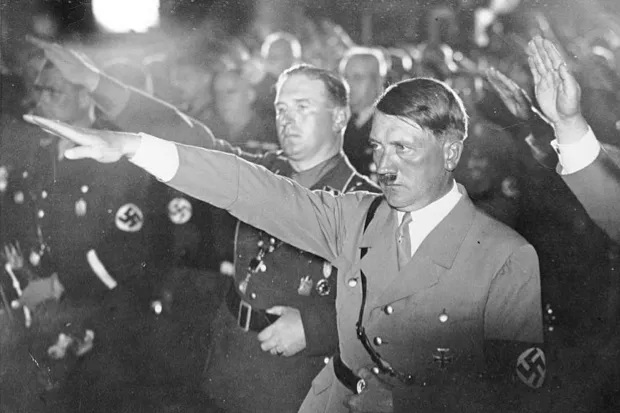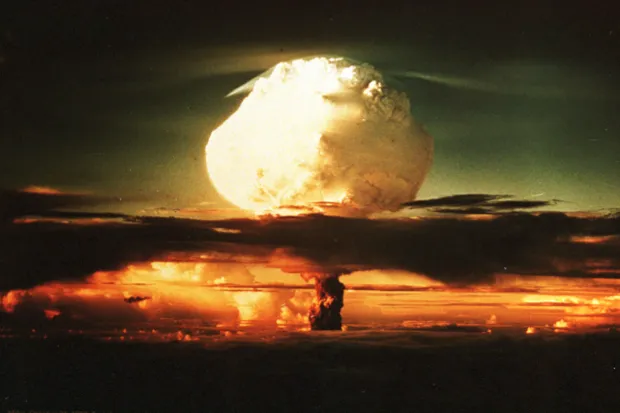One day in July 1938, a car pulls up at the train station in Berlin. A woman climbs out. She shows her travel documents to the armed guards in Nazi uniform. The woman is small and slight, and she seems nervous. On the train she greets a man and they travel together, heading for Groningen in the Netherlands. Are they lovers, perhaps?No, this is not a tryst but a rescue mission. The woman is an Austrian named Lise Meitner, and is one of the most brilliant nuclear scientists working in Germany.
Lise Meitner is of Jewish descent and is fleeing Adolf Hitler’s regime when it is almost too late. The Nazi leaders have introduced a policy prohibiting all scientists from leaving Germany, and they have forbidden Meitner from gaining the documents that would offer her freedom to travel. At the Dutch border, a Nazi military patrol makes its way through the carriages of the train, checking documents. Meitner’s travelling companion, a Danish chemist named Dirk Coster, has negotiated permission from the Dutch authorities for her to enter the country. But all she has as identification is her Austrian passport – and it is obsolete. “I got so frightened, my heart almost stopped beating,” Meitner later recalled. “I knew that the Nazis had just declared open season on Jews, that the hunt was on. For 10 minutes I sat there and waited, 10 minutes that seemed like so many hours. Then one of the Nazi officials returned and handed me back the passport without a word.”
Minutes later, she was safely across the Dutch border. Once they arrived in Groningen, Coster sent a coded telegram back to Meitner’s former scientific collaborator in Berlin, chemist Otto Hahn, to say that the ‘baby’ had arrived.
When Hitler came to power a few years earlier in 1933, his anti-Semitic policies lost German science many great researchers. Most famously, Albert Einstein, who was on a tour of the US when the election result was announced, never returned. But few would have been as valuable to Germany as Meitner.
A few months after her dramatic escape from Nazi Germany, Lise Meitner was living in Sweden. She was told about the latest results that Hahn had obtained in his work on the radioactive decay of uranium. And she realised what Hahn did not: that uranium was undergoing nuclear fission, splitting in half and releasing some of its tremendous store of nuclear energy.
Seven years later, on 6 August 1945, that same process of nuclear fission in uranium was triggered inside Little Boy, the bomb that was dropped over the Japanese city of Hiroshima. The rest, you might say, is history – except that it is a history still all too present today, when the threat of nuclear conflict lies once again over the world. It was Meitner’s insight that launched the nuclear age.
Glowing career
Meitner’s career launched in 1901, when she decided to start studying physics at the University of Vienna. After achieving a doctorate, she arrived in Berlin in 1907 to take her studies further, but at the time Prussia (an historic German state, with Berlin as its capital) still did not admit women to its universities. That changed the following year, but attitudes did not. Hahn first met Meitner that autumn and they decided to work together. But women were not permitted inside Hahn’s chemistry institute, allegedly because its director was convinced they would set their hair on fire. As a compromise, Meitner was given a room in the basement, but forbidden to come upstairs, even to talk to Hahn.
In 1912, Hahn and Meitner moved to the Kaiser Wilhelm Institute for Chemistry (KWIC) to study radioactivity. This was the early 20th Century, and radioactivity was an exciting field for scientists because it offered clues about what atoms were made from. Researchers established that atoms have an internal structure, consisting of a positively charged super-dense nucleus made up of protons and neutrons, surrounded by negatively charged particles called electrons.
Scientists had also discovered that nuclear decay, and nuclear reactions triggered by collisions of subatomic particles with atoms, could convert one chemical element into another. And they found a whole bunch of new elements: Meitner and Hahn discovered protactinium in 1917.
Living under the swastika
During her time at KWIC, Meitner’s determination and sharp mind soon earned her respect. By the 1930s, she was considered one of Germany’s foremost nuclear scientists. But then everything changed.
In January 1933, Adolf Hitler was appointed Chancellor, and he moved swiftly to transform Germany from a democracy to a dictatorship. In April that year, the Nazis expelled Jews from all places of power and influence, including academic jobs. Yet somehow, Meitner managed to retain an academic post for a further five years. She was dismissed from the University of Berlin, barred from speaking at scientific meetings, and all but erased from the official narrative of German nuclear physics during that time, so that her joint discoveries with Hahn were attributed to him alone. Nevertheless, she was able to stay in active research at KWIC. Hahn and Meitner, assisted by a young German chemist named Fritz Strassmann, began to gather evidence for new types of radioactive substances created from uranium, perhaps including some hitherto unknown elements.

But when Germany annexed Austria in the Anschluss of March 1938, being an Austrian Jew in Berlin was no longer merely anomalous but perilous. Jews in Vienna were turned out of their homes and brutally beaten; some were murdered. Nazi sympathisers in Berlin no longer bothered to moderate their language – her colleague Kurt 2 2 Hess, who was an ardent Nazi, said of Meitner that “the Jewess endangers this institute.” Hahn, who had been Lise Meitner’s closest colleague for 20 years, capitulated, telling her that she must leave the institute. “He has, in essence, thrown me out,” Meitner recorded bitterly in her diary.
It was time to leave, and fast. Dirk Coster at the University of Groningen in the Netherlands had been arranging emergency help for refugee scientists coming from Germany, and on 11 July 1938 he received official confirmation that Meitner would be admitted into the Netherlands. Two days later, he was accompanying Meitner on her escape from Berlin.
Splitting apart
Following Meitner’s escape from Germany, Hahn and Strassmann continued the uranium experiments. But without Meitner’s expertise they had difficulty interpreting what they saw. They found that uranium could be transformed by neutron bombardment into radioactive substances that seemed chemically similar to barium, a much lighter element. They wrote to Meitner, now in Stockholm, who replied that it did not seem credible. Radioactive transmutations were thought to happen only a little at a time: a radioactive decay would turn one element into another with very similar mass. Yet barium had barely half the mass of uranium.
That Christmas, while on holiday in a quiet Swedish village, Lise Meitner discussed the peculiar results with her visiting nephew, the physicist Otto Frisch. He had also been exiled from Germany and was now working in Copenhagen. They came to a conclusion that contravened all prevailing wisdom about nuclear transmutation. The uranium nuclei, they decided, had indeed been more or less split in half – raising the prospect of an enormous release of nuclear energy. Searching for a name for this process, Frisch recalled the division of living cells, and borrowed the biological term for it: uranium underwent nuclear fission.
By the end of April 1939, German physicists had told the Nazi government about the potential of nuclear fission to provide energy and explosives, and the authorities declared that such research should be kept secret. But word had already got out. In August, Einstein and other scientists wrote a letter to President Roosevelt warning of the feasibility of making an atomic bomb.
Later that year, the German physicist Werner Heisenberg wrote a report for Nazi officials on the possibility of liberating energy by controlled fission in a uranium-fuelled nuclear reactor – and perhaps also in a bomb. Heisenberg was put in charge of the research to harness this nuclear energy. But the German scientists, lacking the funding and hampered by Allied bombing raids, hadn’t progressed very far towards either a nuclear reactor or a bomb by the end of the war. They were as surprised as the rest of the world when they heard in August 1945 of the bombing of Hiroshima.

That capacity for destruction wasn’t the only feature of nuclear fission, though. In the midst of the war, scientists working under Italian physicist Enrico Fermi in Chicago figured out how to control fission so that it didn’t become a runaway process: uranium released its nuclear energy only gradually, generating heat that could be used to boil water and drive turbines for electrical power generation. Fermi’s success,informed by Meitner’s insight, led to the advent of nuclear power. Still today, most nuclear power stations rely on uranium fission to produce energy, although there are hopes that one day it will be possible instead to harness nuclear fusion, the process that fuels the Sun, in which very light atomic nuclei release energy as they fuse together. The problems of nuclear fission, especially the production of hazardous nuclear waste, are well known. But in the face of global warming caused partly by the burning of carbon-based fossil fuels like oil and coal, some environmentalists are today turning to nuclear power as a partial solution to the problems we are creating in the Earth’s climate.
The conscience of German science
Meitner refused to play any part in the Manhattan Project in which the Allies developed the atomic bomb. “I will have nothing to do with a bomb!” she declared. Being celebrated in America after the war as the “Jewish mother of the bomb”, who somehow kept the secret from Hitler, dismayed her. But much of her energy in the immediate post-war period was spent trying to persuade her former colleagues in Germany to acknowledge and accept their part of responsibility for staying quiet during the horrors that had happened in the Third Reich – over which many of the scientists now wished to draw a veil.
The Allied advance into Germany revealed those horrors to the world, and showed Meitner what she had narrowly escaped. When the troops reached the concentration camps at Dachau and Buchenwald, she wept as she listened to the radio reports. “Someone,” she wrote to Hahn, who was interned in Cambridgeshire in June 1945, “should force a man like Heisenberg and many million others to look at those camps and at the martyred people.”
It took Hahn many years to admit his own culpability. In 1958, he wrote to Meitner on her 80th birthday: “We all knew that injustice was taking place, but we didn’t want to see it, we deceived ourselves… Come the year 1933 I followed a flag that we should have torn down immediately. I did not do so, and now I must bear responsibility for it.”
He thanked Meitner “for trying to make us understand, for guiding us with remarkable tact” towards a recognition of the way the German physicists had worked under, and in many ways for, a monstrous regime. Of the fine words that were later bestowed upon scientists who worked in Nazi Germany, few speak so eloquently as those on Lise Meitner’s tombstone in Hampshire, southern England, where she died in 1968. They pronounce her “a physicist who never lost her humanity”.
- This is an extract from issue 315 ofBBC Focusmagazine, first published in November 2017 - subscribe here
